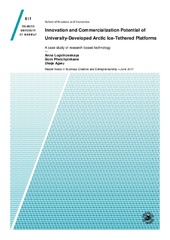Monitoring marine mammals using unmanned aerial vehicles: quantifying detection certainty
Permanent link
https://hdl.handle.net/10037/13494Date
2018-03-08Type
Journal articleTidsskriftartikkel
Peer reviewed
Author
Aniceto, Ana Sofia; Biuw, Martin; Lindstrøm, Ulf; Solbø, Stian; Broms, Fredrik Björn; Carroll, JoLynnAbstract
Unmanned aerial vehicles (UAVs) are increasingly being recognized as potentially useful for detection of marine mammals in their natural habitats, but an important consideration is the associated uncertainties in animal detection. We present a study based on field trials using UAVs to carry out image‐based monitoring of cetaceans in two fjords in northern Norway. We conducted 12 missions to assess the effects of both environmental‐ and aircraft‐related variables on detection certainty. Images were inspected for animal presence and its associated detection certainty. Images were also assessed for potentially important covariates such as wave turbulence (sea state), luminance, and glare. Aircraft variables such as altitude, pitch, and roll were combined into a single variable—pixel size. We recorded a total of 50 humpback whales, 63 killer whales (KW), and 118 unidentified sightings. We also recorded 57 harbor porpoise sightings. None of the environmental conditions (sea state, glare, and luminance) affected the detection certainty of harbor porpoises. In contrast, increasing sea state and luminance had negative and positive effects, respectively, on the detection certainty of humpback and KW. The detection certainty was not significantly affected by pixel size for both harbor porpoises, and humpback and KW. Our results indicate that at lower altitudes, variations in aircraft position (pitch and roll) do not have a variable effect on detection certainty. Overall, this study shows the importance of measuring variability in both environmental and flight‐related variables, in order to attain unbiased estimates of detectability for UAV‐based marine mammal surveys, particularly in Arctic and sub‐Arctic regions.
Description
Source at https://doi.org/10.1002/ecs2.2122. Licensed CC BY-NC-ND 4.0.
Is part of
Aniceto, A.S. (2018). Unmanned aerial vehicles for marine mammal surveys in arctic and sub-arctic regions. Doctoral thesis. http://hdl.handle.net/10037/14008Publisher
Ecological Society of AmericaCitation
Aniceto, A.S., Biuw, M., Lindstrøm, U., Solbø, S.A., Broms, F.B. & Carroll, J. (2018). Monitoring marine mammals using unmanned aerial vehicles: Quantifying detection certainty. Ecosphere, 9(3). https://doi.org/10.1002/ecs2.2122Metadata
Show full item recordCollections
Related items
Showing items related by title, author, creator and subject.
-
Innovation and commercialization potential of university-developed arctic ice-tethered platforms. A case study of research-based technology
Agwu, Ukeje Jacob; Logvinovskaya, Anna; Phetchpinkaew, Gorn (Master thesis; Mastergradsoppgave, 2017-05-31)The Arctic is a region which is rapidly opening up for business opportunities. However, research has been abundant here for a long time. With this situation comes the avenue to transition technology used in the region from research to commercial purposes. In this thesis, a business case is developed to show the commercial potential of research-based technology. The case technology was developed by ... -
Wireless charging of offshore wind service vessels
Nilsen, Henrik Fjeld (Master thesis; Mastergradsoppgave, 2021-05-18)This report discusses the possibility for wireless charging solutions for electric vessels, with a focus on offshore wind turbine service. Where the charging time is minimal and safety for crew is important. Different types of wireless technologies have been studied, where the Inductive power transfer (IPT) is shown to be the preferred technology. Inductive power transfer (IPT) grants a safe ... -
On the use of the HUGIN 1000 HUS Autonomous Underwater Vehicle for high resolution zooplankton measurements
Pedersen, Ole Petter; Gaardsted, Frank; Lågstad, Petter Arthur; Tande, Kurt Steinar (Journal article; Tidsskriftartikkel; Peer reviewed, 2010)This paper evaluates and tests the HUGIN 1000 HUS AUV as a carrier platform for the Laser Optical Plankton Counter (LOPC). The LOPC was mounted outside on top of the carrier platform, and the tests confirm that this concept did not create turbulence and zooplankton avoidance. A negligible velocity difference between the flow passing through the sampling tube and the AUV speed was detected. The ...


 English
English norsk
norsk


